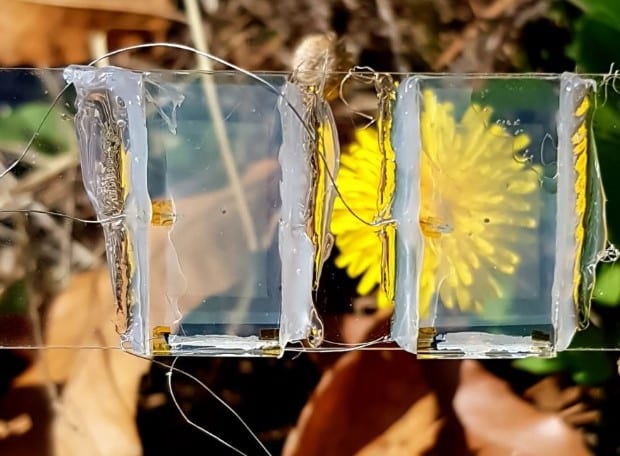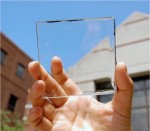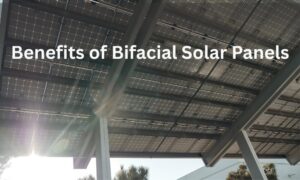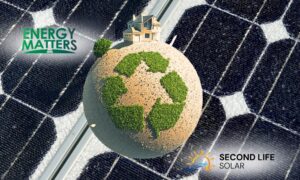Advanced transparent solar technology collects and uses light energy through windows or any other glass surface, regardless of angle. It could revolutionise the solar industry by extending its application.
In 2014, scientists at Michigan State University (MSU) created a solar concentrator that was completely transparent and could turn practically any glass sheet or window into a photovoltaic cell.

Image: Michigan State University
And by 2020, researchers in the US and Europe made solar glass completely transparent, moving us one step closer to the objective of a sustainable future independent of the fossil fuel industry’s grid.
What are transparent solar panels?
Transparent solar cell technology, also known as photovoltaic glass and see-through solar glass, is created to offer a variety of transparency levels. Transparent solar panels are see-through solar panels often composed of glass. It is a prime example of building-integrated photovoltaics (BIPV) due to its elegant, understated appearance, which makes it perfect for usage in place of normal glass.
These transparent solar panels can also be installed on the roofs of cars, homes, workplaces, and even smartphones and produce electricity from windows. Another window component that can produce electricity is the blinds.
On the other hand, traditional solar panels are visible and typically installed on top of a building rather than being integrated into it. They typically come in black or blue. Transparent solar panels solve some people’s aesthetic issues with solar panels.
Building-integrated photovoltaics (BiPV) at a glance
Building-integrated photovoltaics (BiPV) products are solar energy-generating photovoltaic materials that replace traditional building materials in areas of a building’s envelope like the roof, skylights, or façade. As a primary or auxiliary source of electricity, BiPV is increasingly being employed in constructing new buildings and renovating older structures.
Australian BiPV projects:
- The canopy on the NSW Government’s Como Station Upgrade, Sydney.
- The canopy of the Chapter House Canopy, St Andrew’s Cathedral refurbishment, Sydney.
- The award-winning The General building at Northcote in Melbourne.
- The scenic photovoltaic pergola at The Coal Loader Centre for Sustainability at Balls Head on Sydney Harbour.
NSW’s sole Onyx Solar BiPV distributor
Spain’s Onyx Solar has only one distributor in New South Wales, however, Hume Building Products is a reputable distributor all over Australia. Onyx is the top producer of clear photovoltaic (PV) glass for structures. Over 200 projects worldwide have employed Onyx BiPV products.
Energy Matters has helped over 40,000 Australian households in their journey to energy independence.
Let us discuss and choose the best quote that suits your needs and budget, and we can connect you with our trusted local installers, who will provide up to 3 FREE quotes. Complete our quick quiz and begin your solar journey today!
Types of transparent solar panels
Solar windows also exist using various technological techniques like Tesla solar shingles and others. The two main types of transparent panel systems are partially or fully transparent solar panels.
Partially transparent solar panels
A German company called Heliatek GmbH has created solar panels that are partially transparent and absorb 60% of the sunlight that hits them. These panels’ efficiency is 7.2% compared to this manufacturer’s normal solar photovoltaic panels’ efficiency of 12%. Only 60% of the light is absorbed by the panel, while the other 40% is transmitted through the panel, decreasing efficiency. Here, Heliatek demonstrates how changing the ratio of transmitted and absorbed light can change the amount of solar energy produced.
Tinted glass is already used in office buildings with extensive south-facing glass surfaces to minimise transmitted sunlight.
For situations like this, partially transparent solar panels have significant commercial potential.
Fully transparent solar panels
Solar panels that are partially transparent are appropriate for the conditions stated above, but they could be better for touchscreens or clear windows. However, a development made by scientists at Michigan State University, who created a transparent solar panel that mimics regular glass, might meet this need.
By definition, a completely transparent solar panel could not collect sunlight. However, researchers at Michigan State University utilised organic compounds that absorb particular invisible light wavelengths, such as ultraviolet light. Following its transformation, this light is moved to the panel’s edges by its substance, where it is converted into electricity by photovoltaic solar cell stripes.
You may already have an energy plan but want to shop for a better deal.
Energy Matters’ “Energy Health Check” is a cutting-edge energy comparator tool that allows you to compare your area’s most competitive retail offers. We collect the data from our wide range of trusted retailers, allowing you to decide about changing your plan.
If your goal is to minimise the cost of your gas and electricity bills, switch to a better plan now!
Comparison between opaque and transparent solar panels
A comparison between opaque and transparent solar panels reveals distinct advantages and applications for each type.
Opaque solar panels
Commonly seen in traditional solar installations, they are highly efficient in converting sunlight into electricity. They are ideal for large-scale solar farms and rooftops where maximising energy production is a priority. Opaque panels have a higher power conversion efficiency due to their solid construction, which allows them to capture a significant amount of sunlight and generate more electricity per unit area. These panels are widely used in utility-scale projects, contributing to Australia’s renewable energy goals and grid integration.
Transparent solar panels
Transparent solar panels offer unique benefits that make them valuable in specific applications. Transparent panels are increasingly being integrated into architectural designs, such as windows and facades of buildings. This integration allows for the generation of clean and renewable energy without sacrificing natural light or obstructing the view. The aesthetic appeal and functionality of structures are maintained while simultaneously harnessing solar energy. Moreover, transparent solar panels find applications in portable devices and transportation. They can be integrated into camping gear and even vehicles, providing a lightweight and portable energy source. This flexibility allows for off-grid energy generation, particularly in remote areas where traditional power infrastructure is limited. The rise of transparent solar panels in Australia demonstrates their potential for sustainable and innovative solutions across various sectors.
How does energy from the sun windows work efficiently?
Since solar cells must collect sunlight (photons) and convert them into power, a transparent solar panel is fundamentally nonsensical (electrons). A transparent solar glass will allow sunlight to pass through it, defeating the goal of using sunlight. However, the way solar cells absorb light is changing due to this new solar panel technology.
While enabling regular visible light to flow through, the cell selectively captures a section of the solar spectrum that is invisible to the human eye. Instead of attempting the impossibility of producing a transparent photovoltaic glass cell, the researchers created the transparent luminescent solar concentrator (TLSC) to achieve this marvel of engineering.
Advantages of transparent solar panels
Renewable energy generation
Transparent solar panels harness the power of sunlight to generate electricity, providing a renewable energy source. This helps reduce reliance on fossil fuels and contributes to a cleaner and more sustainable energy future.
Integration into architecture
Transparent solar panels have the advantage of being seamlessly integrated into buildings and structures. They can be incorporated into windows, facades, or skylights, allowing for the generation of solar energy without compromising the aesthetic appeal of the structure.
Increased energy efficiency
By converting sunlight into electricity, transparent solar panels can help reduce energy consumption from the grid. They can generate power even in low-light conditions, making them a viable energy option throughout the year.
Reduced carbon footprint
With transparent solar panels, individuals and businesses can significantly reduce their carbon footprint. By generating clean energy on-site, less greenhouse gas emissions are released into the atmosphere, contributing to mitigating climate change.
Cost savings
Transparent solar panels offer potential cost savings by generating electricity on-site, reducing the need to purchase power from the grid. Over time, this can lead to lower energy bills and provide a return on investment for individuals and businesses.
Disadvantages of Transparent Solar Panels
Lower efficiency
Transparent solar panels typically have lower efficiency compared to traditional opaque solar panels. The transparent nature of the panels limits the amount of sunlight that can be captured and converted into electricity, resulting in lower overall power output.
Higher costs
Transparent solar panels can be more expensive compared to traditional solar panels due to the additional technology and manufacturing processes involved. The cost may limit their widespread adoption, especially for large-scale applications.
Limited power generation
The current technology of transparent solar panels is not as advanced as traditional solar panels in terms of power generation capacity. This limitation restricts their use to smaller-scale applications or as a complementary energy source rather than a primary one.
Maintenance and durability
Transparent solar panels may require additional maintenance compared to traditional solar panels due to their integrated nature. Any damage to the panel, such as cracks or scratches, can affect its efficiency and longevity. Proper care and maintenance are necessary to ensure optimal performance.
Availability and accessibility
Transparent solar panels are still relatively new and not as widely available as traditional solar panels. Their accessibility may be limited, making it challenging for individuals or businesses to access and install them easily.
Applications of transparent solar panels
One significant application lies in the construction industry, where transparent solar panels are being integrated into the windows and facades of buildings. This integration allows for the generation of clean and renewable energy without compromising the aesthetic appeal or functionality of the structures. Additionally, transparent solar panels are finding their place in transportation, with prototypes of solar-powered electric vehicles incorporating these panels into their roofs and windows, providing an additional power source and reducing reliance on traditional charging methods. The growing adoption of transparent solar panels in Australia marks a crucial step towards sustainable and energy-efficient practices in diverse sectors.
Moreover, the agricultural sector in Australia is embracing the potential of transparent solar panels to enhance farm operations and sustainability. By installing these panels on greenhouses and agricultural structures, farmers can generate electricity while allowing sunlight to pass through for optimal plant growth. This dual-purpose application not only reduces the reliance on fossil fuels but also maximises land usage and boosts overall energy efficiency in the agricultural industry. Furthermore, transparent solar panels have gained traction in remote areas where traditional power infrastructure is limited. These panels can be integrated into portable devices, such as backpacks and camping gear, enabling hikers and campers to generate electricity on the go and meet their energy needs even in remote locations. The versatile and environmentally-friendly nature of transparent solar panels positions them as a promising technology for a sustainable future in Australia.
Transparent solar panel research and manufacturing
Researchers contend that since transparent panels might replace existing windows, they could make up for the inefficiency with volume. Still, they could never be as efficient as opaque panels. However, the reality is more complicated, and teams from around the world have created a variety of approaches to construct that ostensibly straightforward concept.
ClearVue
More installations and details are available publicly through an Australian company named ClearVue. Similar to Ubiquitous Energy’s idea, it directs light to solar cells in the window frame using a film sandwiched between layers of glass.
Universities, opulent homes, and most notably, the Warwick Shopping Centre Atrium have installed ClearVue’s windows, which the company claims generate roughly 1.6 kWh daily from 25 square metres of window space. And that’s after accounting for battery and DC-to-AC losses, which is very good.
Ubiquitous Energy
In the US, MIT professor Vladimir Bulovi and Michigan State University professor Richard Lunt, whose research started at MIT before relocating to Michigan—are primarily credited with developing transparent solar technology. At MSU in 2015, Lunt showed the technology.
The two co-founded Ubiquitous Energy with Miles Barr to benefit from the technology.
The company boasts that its solar panels are the only transparent ones worldwide. Still, they are only 40–80% transparent and have an efficiency of up to 10% (the best solar panels now available have a 23% efficiency).
Building windows will now have solar glazing thanks to a partnership between Ubiquitous Energy and Antamex.
NSG Group, also known as Nippon Sheet Glass Co. Ltd., is among the biggest producers of glass and glazing goods for commercial use. To incorporate UE’s ClearView Power solar coating onto the architectural glass, Ubiquitous Energy and NSG partnered.
SolarGaps' solar panel blinds
In addition to transparent solar glass or panels; solar panel blinds can also generate electricity through windows. The primary purpose of window blinds is to prevent direct sunlight from entering a room, whereas solar power panels are made to capture sunlight to generate electricity.
Solar panel blinds are a creative way to combine these two different purposes. A cutting-edge company called SolarGaps has developed solar panel blinds, which the company claims can reduce energy bills by up to 70%. For each 10 sq. These solar window blinds provide a 100 watt power output per square foot of window space (you could roughly power three laptops with this much electricity).
Insolight
The Swiss company Insolight, which makes THEIA agrovoltaic panels, is one of the most intriguing businesses working on transparent solar.
With up to 30% efficiency, Insolight claims to have the world’s most effective translucent photovoltaic module. It is a result of the distinctive hexagonal lenses used by Insolight to focus sunlight.
Incheon National University
A fully transparent solar panel was unveiled by Professor Joondong Kim of Incheon National University in South Korea as a new development in transparent solar technology. Professor Kim’s method embeds titanium dioxide or nickel oxide directly into the glass to absorb solar energy. They are both highly transparent optically. While nickel oxide is abundant enough for low-cost manufacture, titanium dioxide is currently utilised in solar cells and is environmentally favourable.

Source&Image: Incheon National University (photo by Professor Joondong Kim)
Professor Kim expects that he could incorporate cell into phone screens because the panels are entirely transparent. However, since the cells only have a 2.1% efficiency, commercial applications are probably several years away. It could be clearer how much of a difference the panels would make for battery life because a phone has less glass than a building, although they are impressive considering their transparency.
Contact us for professional guidance and a price estimate for a home or business’ high-quality solar panel installation.
Energy Matters has been a leader in the renewable energy industry since 2005. We can connect you with our trusted local installers, who will provide up to 3 FREE solar quotes for your home and business solar energy system.














































